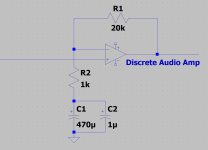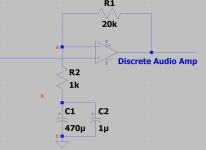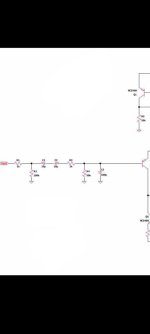I doubt, in the world of todays higher quality electrolytic capacitors, you would notice any difference.
Place another 1k between point A & B.
Place C2 between points B & C.
That will give you a 6dB extra gain a higher frequencies, assuming the IC has a fast enough slew rate.
Place another 1k between point A & B.
Place C2 between points B & C.
That will give you a 6dB extra gain a higher frequencies, assuming the IC has a fast enough slew rate.
Attachments
I'd love to see the evidence or science that supports the paralleling of electrolytics with a small non electrolytic.
If you can hear a difference then maybe you should use a better quality electrolytic in the first place?
If you can hear a difference then maybe you should use a better quality electrolytic in the first place?
It really depends on R2. Since you’re in series with 1k ohms, a few ohms of ESR or ESL will be lost in the noise. By the time the impedance does start rising you’ll be running out of gain in the amp anyway. Where it is critical to maintain low impedance beyond a couple MHZ then the small cap is needed. If you were doing a wide band CFA with a 47 ohm resistor there (and the required 1000 uF cap) then you definitely need to look into it.
I put a 0.1uF ceramic capacitor in parallel to keep the impedance low at radio frequencies. I also use a non-polarized electrolytic.
Ed
Ed
It wouldn't hurt anything, and most likely won't help anything, either. By time any parasitics in the 'lytic start to have effect on the signal, the frequency where those effects start to kick in will be far, far above audibility. So if it feels better to add the cap, go ahead.Hi! , is it a good practice to add a small value capacitor ( for " better high end " ) in parallel with the feedback cap? , what value would be " best " ? .
What about the input cap in parallel with a small one ?.
@batteryman - The feedback network has to remain well-behaved far past the unity gain frequency. RFI suppression is done separately.
Ed
Ed
Power amps often have an inductor between output and speaker to block RF from getting back into the amp.
Most feedback networks have a capacitor across the resistor to reduce the gain at high frequencies so they are not troublesome.
I can see no justification using a capacitor to allow an RF path into any amp or preamp.
Most feedback networks have a capacitor across the resistor to reduce the gain at high frequencies so they are not troublesome.
I can see no justification using a capacitor to allow an RF path into any amp or preamp.
C2 does not allow RF entry. It prevents the loop gain from rising at high frequencies (megahertz).
BTW, the lead compensation capacitor causes RF at the output to be fed back to the input. This is a good reason not to use a lead capacitor.
Ed
BTW, the lead compensation capacitor causes RF at the output to be fed back to the input. This is a good reason not to use a lead capacitor.
Ed
Can you " make " a non polarized cap from two electrolytics like this?.
I've seen this with two + to + or - to - in some Japanese amps . Any benefit of doing that? Actually you would increase the ESR and lower the capacity, also increase voltage, but
( I know how a cap works, but I did not find what makes a non polar cap different from polarised with +- , physically, internal structure speaking. ?. )
I've seen this with two + to + or - to - in some Japanese amps . Any benefit of doing that? Actually you would increase the ESR and lower the capacity, also increase voltage, but
( I know how a cap works, but I did not find what makes a non polar cap different from polarised with +- , physically, internal structure speaking. ?. )
Attachments
An NPE isn’t constructed any differently. It is not going to be any better electrically than placing two regular caps (of the same quality construction) in inverse series.
And since we're talking about caps: what type:ceramic, film foil, styroflex , is better for Cdom, or from base to collector on drivers. ( 100p or so ) .
What type for Decoupling?
What about zobel network?.
In a Yamaha amp I found big bulky 150p film I think, caps .
I've seen many different types in different amps, maybe cost is also a factor of choosing what type to be used.
- Bruno.
What type for Decoupling?
What about zobel network?.
In a Yamaha amp I found big bulky 150p film I think, caps .
I've seen many different types in different amps, maybe cost is also a factor of choosing what type to be used.
- Bruno.
https://www.digikey.com/en/articles/what-is-a-capacitor-and-what-are-the-different-types
Ed
Bi-polar electrolytic capacitors are designed to operate without damage when subject to voltages that change polarity, by forming an oxide film on both of the foil sheets used in a standard aluminum electrolytic capacitor, rather than just one. Because of the high ESR of such devices they’re generally considered unsuitable for operations with a continuously applied AC voltage, and for this reason are occasionally referred to as “non-polar DC capacitors” to emphasize the point. Their use is typically limited to DC applications where the polarity to be applied is uncertain, may occasionally reverse on a transient basis, or where the current flow through the device can be limited to values that do not result in excess self-heating.
Ed
For Cdom the physically BEST cap is polystyrene. Temp stable, low distortion but fragile, expensive, hard to find. Myself I use silvered mica. Relatively high ESR but that doesn’t drive performance. Tough as nails and you don’t have to worry about voltage (500V is common).
Best small caps for decoupling are actually ceramic if they are needed to suppress RF oscillations.
For zobel, mylar film. Polypropylene is fine but unnecessary. It’s got 4 to 10 ohms of resistor in series with it anyway, what’s a little more going to hurt? Save the MKPs for where you need them.
Best small caps for decoupling are actually ceramic if they are needed to suppress RF oscillations.
For zobel, mylar film. Polypropylene is fine but unnecessary. It’s got 4 to 10 ohms of resistor in series with it anyway, what’s a little more going to hurt? Save the MKPs for where you need them.
See https://www.diyaudio.com/community/...k-to-back-standard.336838/page-2#post-7580850Can you " make " a non polarized cap from two electrolytics like this?.
I've seen this with two + to + or - to - in some Japanese amps . Any benefit of doing that? Actually you would increase the ESR and lower the capacity, also increase voltage, but
( I know how a cap works, but I did not find what makes a non polar cap different from polarised with +- , physically, internal structure speaking. ?. )
- Home
- Amplifiers
- Solid State
- Capacitor Question


